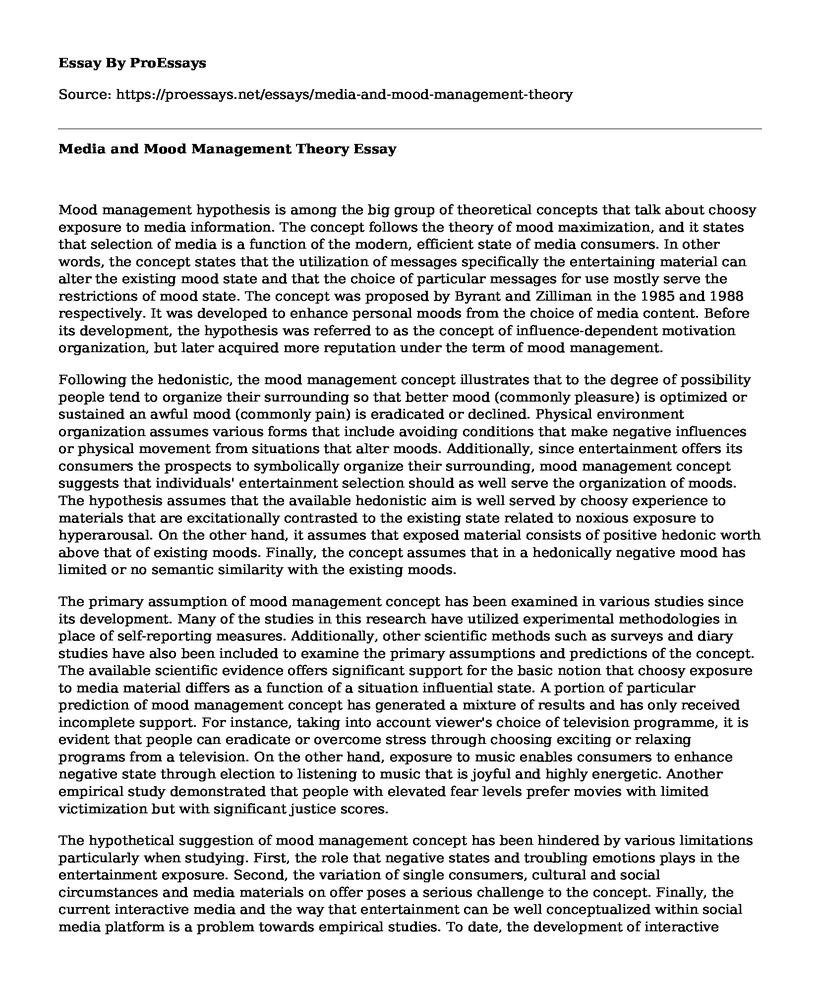Mood management hypothesis is among the big group of theoretical concepts that talk about choosy exposure to media information. The concept follows the theory of mood maximization, and it states that selection of media is a function of the modern, efficient state of media consumers. In other words, the concept states that the utilization of messages specifically the entertaining material can alter the existing mood state and that the choice of particular messages for use mostly serve the restrictions of mood state. The concept was proposed by Byrant and Zilliman in the 1985 and 1988 respectively. It was developed to enhance personal moods from the choice of media content. Before its development, the hypothesis was referred to as the concept of influence-dependent motivation organization, but later acquired more reputation under the term of mood management.
Following the hedonistic, the mood management concept illustrates that to the degree of possibility people tend to organize their surrounding so that better mood (commonly pleasure) is optimized or sustained an awful mood (commonly pain) is eradicated or declined. Physical environment organization assumes various forms that include avoiding conditions that make negative influences or physical movement from situations that alter moods. Additionally, since entertainment offers its consumers the prospects to symbolically organize their surrounding, mood management concept suggests that individuals' entertainment selection should as well serve the organization of moods. The hypothesis assumes that the available hedonistic aim is well served by choosy experience to materials that are excitationally contrasted to the existing state related to noxious exposure to hyperarousal. On the other hand, it assumes that exposed material consists of positive hedonic worth above that of existing moods. Finally, the concept assumes that in a hedonically negative mood has limited or no semantic similarity with the existing moods.
The primary assumption of mood management concept has been examined in various studies since its development. Many of the studies in this research have utilized experimental methodologies in place of self-reporting measures. Additionally, other scientific methods such as surveys and diary studies have also been included to examine the primary assumptions and predictions of the concept. The available scientific evidence offers significant support for the basic notion that choosy exposure to media material differs as a function of a situation influential state. A portion of particular prediction of mood management concept has generated a mixture of results and has only received incomplete support. For instance, taking into account viewer's choice of television programme, it is evident that people can eradicate or overcome stress through choosing exciting or relaxing programs from a television. On the other hand, exposure to music enables consumers to enhance negative state through election to listening to music that is joyful and highly energetic. Another empirical study demonstrated that people with elevated fear levels prefer movies with limited victimization but with significant justice scores.
The hypothetical suggestion of mood management concept has been hindered by various limitations particularly when studying. First, the role that negative states and troubling emotions plays in the entertainment exposure. Second, the variation of single consumers, cultural and social circumstances and media materials on offer poses a serious challenge to the concept. Finally, the current interactive media and the way that entertainment can be well conceptualized within social media platform is a problem towards empirical studies. To date, the development of interactive media has brought interesting fresh challenges to mood management studies. Contrary to ancient noninteractive media stimulus that presented similar content, structures and appearances to all consumers, modern media interaction such as video games and online social media platforms makes people react towards them and can be altered to suit the users activities. This means that the stimulus environment can be changed depending on personal usage arrangements.
Cite this page
Media and Mood Management Theory. (2022, Apr 04). Retrieved from https://proessays.net/essays/media-and-mood-management-theory
If you are the original author of this essay and no longer wish to have it published on the ProEssays website, please click below to request its removal:
- Liquidity Analysis for Apple Paper Example
- Leadership Training Course Options Report
- The Seven Years' War Paper Example
- Anzac Day: Remembering NZ's National Identity & Loss of Lives - Essay Sample
- Essay Example on Scrum: Simple Framework for High Quality Product Development
- Strategic Leadership: A Necessary Core for Effective Growth - Research Paper Sample
- Free Education - Essay Example







